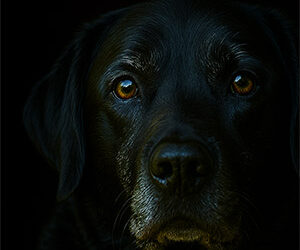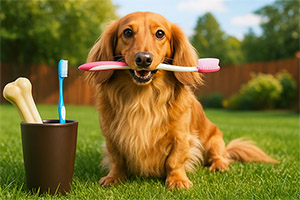While it may sound unusual, dogs also accumulate tartar. Just like humans, brushing your dog’s teeth is critically important.
Plaque and tartar buildup over years can lead to gingivitis (gum inflammation), periodontitis, or in other words, dental and periodontal disease, along with many other serious health conditions.
Periodontal disease in dogs typically appears in those over 5 years old, but this doesn’t mean you should neglect oral hygiene when they’re young.
Plaque appears as a yellow-brown discoloration on teeth, located near the gumline. Tartar accumulates most rapidly and extensively near the salivary glands, as they contain minerals that deposit immediately on teeth. After oral hygiene care, plaque begins to reform within approximately two to five days.

You should begin dental care for your dog from an early age. Puppies have 32 deciduous teeth, while adult dogs have 42 permanent teeth. The earlier you start your dog’s oral hygiene routine, the better. Beyond maintaining healthy teeth, they will also become accustomed to this process over time. Note that small breed dogs, such as bulldogs, pugs, chihuahuas, pinschers, pomeranians, and other breeds, require more frequent teeth brushing.
Bones and hard food that dogs consume provide some degree of teeth cleaning and help prevent rapid formation of tartar and plaque. However, in most cases, this is insufficient.
How to Care for Your Dog’s Teeth
Brushing your dog’s teeth is a process that requires patience and precision. You should use a small toothbrush with soft bristles and specialized canine toothpaste. When preparing to brush your dog’s teeth, it’s important to first let them taste a small amount of the toothpaste so they can associate it with a familiar flavor.
Note that dog toothbrushes come in various sizes—choose one appropriate for your dog’s breed. You can also purchase finger brushes, but exercise caution as dogs may bite. You can use these for brushing smaller puppies’ teeth.
You can also find disposable dental wipes specifically designed for dogs at pet stores. Keep these on hand when you don’t have time for a full tooth brushing session. They clean teeth and gums quickly and easily, and you can use them daily.

Patience is crucial when introducing this new routine to your dog. It’s best to choose an appropriate time for teeth brushing—when your dog feels calm—for example, after playtime when they’re tired and have less energy to resist you.
Additionally, you don’t need to complete the entire process on the first attempt. If your dog becomes restless, stop. Establish a routine and try daily until they eventually allow you to perform the complete brushing procedure. Talk to them, let them sense your calm demeanor, so they understand this is beneficial and nothing to fear.
If you have a puppy, it’s best to train them to accept teeth brushing from an early age rather than waiting until they’re older. This way, you’ll prevent various dental problems.
If you continue to struggle with teaching your dog oral hygiene, don’t pressure them. You can give them a few days’ break. A crucial factor in maintaining healthy teeth is their diet. Dry food is preferable, as soft food can stick to teeth and cause problems that cannot be addressed at this stage.

If you don’t have specialized toothbrushes and toothpaste available, here’s a very useful tip. To remove yellow plaque from your dog’s teeth, mix baking soda and water in equal proportions, then use a small cloth to apply it to your dog’s teeth. Perform gentle motions from top to bottom and vice versa.
To prevent tartar formation in dogs, you should brush your dog’s teeth at least once weekly or rinse with lemon juice.
There are also dental treats that help clean tartar from dogs’ teeth. These are chew sticks available in various flavors. Their shape is designed to better penetrate between teeth and is suitable for all dog breeds.
However, remember that if the problem is severe, it’s best to contact a veterinarian for pet care. Conditions requiring immediate veterinary intervention include: bad breath, broken or missing teeth, bleeding gums, yellowed teeth, excessive drooling (if not characteristic of the breed), inability to eat due to pain.
Provide your dog with a varied diet, primarily consisting of solid food. Purchase chew toys for your dog, take them for regular veterinary checkups, and train them in teeth brushing habits. Following this advice will minimize the risk of dental problems.







